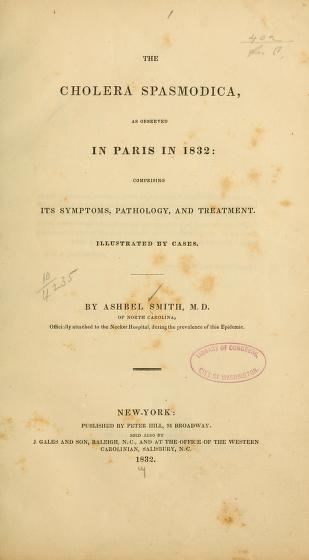John A. Carranza “What I have written on the cholera was commenced in the form of a letter to a medical friend. As I proceeded, my observations spread over a much greater space than I had anticipated, and I resolved to publish them.” [1]
Ashbel Smith, M.D. wrote these words to introduce the subject matter of his book, The Cholera Spasmodica, As Observed in Paris in 1832: Comprising Its Symptoms, Pathology, and Treatment. In this pamphlet, Smith recounts his work in the Necker Hospital in Paris, France during the cholera outbreak of 1832. Smith attempted to study cholera, which confounded the medical community wherever it appeared. What emerged from this publication was a contribution to medical knowledge based on the careful observation and detailed descriptions of cholera. Smith’s examination of bodies, alive and dead, attempted to unite the medical community across geographical space in how they might treat patients.

In the early nineteenth century, medicine began to transition away from what the colonial American physician, Benjamin Rush, called the “heroic therapy,” which consisted of bloodletting and purging. As this transformation occurred, France became a destination for American physicians eager to learn new methods for treating their patients. In cities such as Paris, hospitals were spaces where doctors attained further clinical training. Practicing medicine now included the juxtaposition of clinical observations with research findings. Ashbel Smith, who studied medicine at Yale and earned his medical degree in 1828, made his way to Paris, France where he was present for the cholera outbreak of 1832. While in residence at Necker Hospital, he realized that the instability caused by the cholera outbreak was reason enough to resort to older practices such as bloodletting. Using these old methods of healing despite the transformation in medicine signaled the urgency in trying to heal patients who were dying.[2]
Bearing similarities to other epidemics throughout history, the physicians who were meant to heal were confounded by the epidemic. Ashbel Smith admitted as much when he said:
“Though I bring forward no specific, and profess to know no means which will not leave many to perish, in whom there is a complete development of cholera, yet I hope I have so improved my great and painful opportunities for observation, as to be useful to my countrymen, should this diseases unfortunately appear among us, by insisting on a recourse to medical aid in the stage of formation…by pointing out the means which I have found useless or prejudicial; and by describing the remedies and treatment, which, though they leave much to be desired, are nevertheless followed by more favorable results than any other which I have known and seen employed. ”[3]
In addition to his lack of understanding about cholera, Smith signaled that his pamphlet should be used as a means of preparing American doctors for an outbreak of cholera should it arrive in the United States. In fact, as he mentioned in his preface, cholera had appeared in Canada and soon spread into the United States. During the epidemic, many physicians could not come together to address the health crisis, and in fact, many fled and others profited. Presenting treatments to the American medical community might have benefited doctors by beginning to think as a group about how the disease would be treated.[4]
Quarantine became a method for ensuring that the healthy would not succumb to the disease. However, it’s effectiveness came up for debate. Smith’s observations rightfully noted that using quarantines was ineffective “as if in mockery of them, the cholera leaps over the sanatory cordons enforced by an European police.”[5] Like contemporary physicians, Smith appeared to adhere to the miasmatic theory of medicine in which the air would have carried cholera. Smith mentions that eudiometrical (measuring changes in the volume of a gas mixture) changes had shown no change in the air of spaces crowded with people sick from cholera.[6]
Though Cholera Spasmodica, As Observed in Paris in 1832 yielded very little in understanding the causes and treatment of cholera, it operated as a means of attempting to unite the medical community. The acts of looking at the bodies of the sick and the dead confirmed what many physicians already knew about the cholera patients: their blood often turned a dark color and was congealed, they expelled no urine, and their body was “very dry, as of an animal bled to death…”[7] To counter such symptoms of cholera an array of treatments that included lemonade, hydrotherapy, and remedies were employed, but frequently did not work. Despite the seeming failure to address the cholera outbreaks, Ashbel Smith’s pamphlet gives the historian insight into the importance of medical observation and the possibilities of texts to try to reign in a medical community that was in disarray.
[1] Ashbel Smith, M.D., The Cholera Spasmodica, As Observed in Paris in 1832: Comprising Its Symptoms, Pathology, and Treatment (New York: Peter Hill, 1832), v; Handbook of Texas Online, Elizabeth Silverthorne, “Smith, Ashbel,” accessed December 29, 2017, http://www.tshaonline.org/handbook/online/articles/fsm04. Ashbel Smith’s book can be found at the Dolph Briscoe Center for American History at the University of Texas at Austin.
[2] Ira Rutkow, Seeking the Cure: A History of Medicine in America (New York: Scribner, 2010), 32, 44-45.
[3] Smith, 39-40.
[4] Charles Rosenberg, The Cholera Years: The United States in 1832, 1849, and 1866 (Chicago: The University of Chicago Press, 1987), 68-69.
[5] Smith, 62.
[6] Rosenberg, 79-80; Smith, 62.
[7] Smith, 29.


